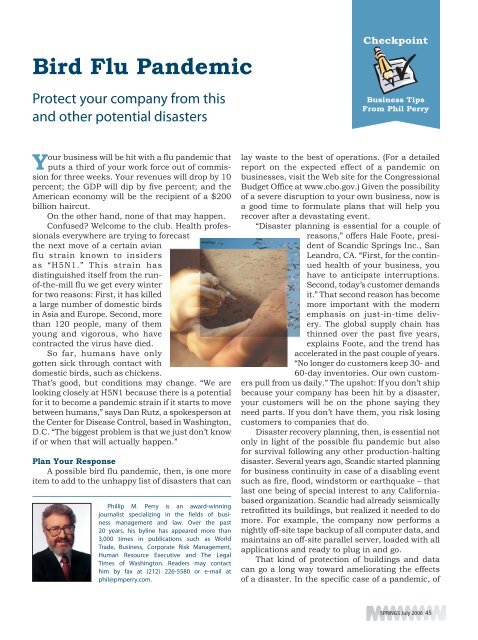Solid Height - Spring Manufacturers Institute
Solid Height - Spring Manufacturers Institute
Solid Height - Spring Manufacturers Institute
You also want an ePaper? Increase the reach of your titles
YUMPU automatically turns print PDFs into web optimized ePapers that Google loves.
Bird Flu Pandemic<br />
Protect your company from this<br />
and other potential disasters<br />
Your business will be hit with a flu pandemic that<br />
puts a third of your work force out of commission<br />
for three weeks. Your revenues will drop by 10<br />
percent; the GDP will dip by five percent; and the<br />
American economy will be the recipient of a $200<br />
billion haircut.<br />
On the other hand, none of that may happen.<br />
Confused? Welcome to the club. Health professionals<br />
everywhere are trying to forecast<br />
the next move of a certain avian<br />
flu strain known to insiders<br />
as “H5N1.” This strain has<br />
distinguished itself from the runof-the-mill<br />
flu we get every winter<br />
for two reasons: First, it has killed<br />
a large number of domestic birds<br />
in Asia and Europe. Second, more<br />
than 120 people, many of them<br />
young and vigorous, who have<br />
contracted the virus have died.<br />
So far, humans have only<br />
gotten sick through contact with<br />
domestic birds, such as chickens.<br />
That’s good, but conditions may change. “We are<br />
looking closely at H5N1 because there is a potential<br />
for it to become a pandemic strain if it starts to move<br />
between humans,” says Dan Rutz, a spokesperson at<br />
the Center for Disease Control, based in Washington,<br />
D.C. “The biggest problem is that we just don’t know<br />
if or when that will actually happen.”<br />
Plan Your Response<br />
A possible bird flu pandemic, then, is one more<br />
item to add to the unhappy list of disasters that can<br />
Phillip M. Perry is an award-winning<br />
journalist specializing in the fields of business<br />
management and law. Over the past<br />
20 years, his byline has appeared more than<br />
3,000 times in publications such as World<br />
Trade, Business, Corporate Risk Management,<br />
Human Resource Executive and The Legal<br />
Times of Washington. Readers may contact<br />
him by fax at (212) 226-5580 or e-mail at<br />
phil@pmperry.com.<br />
Checkpoint<br />
Business Tips<br />
From Phil Perry<br />
lay waste to the best of operations. (For a detailed<br />
report on the expected effect of a pandemic on<br />
businesses, visit the Web site for the Congressional<br />
Budget Office at www.cbo.gov.) Given the possibility<br />
of a severe disruption to your own business, now is<br />
a good time to formulate plans that will help you<br />
recover after a devastating event.<br />
“Disaster planning is essential for a couple of<br />
reasons,” offers Hale Foote, president<br />
of Scandic <strong>Spring</strong>s Inc., San<br />
Leandro, CA. “First, for the continued<br />
health of your business, you<br />
have to anticipate interruptions.<br />
Second, today’s customer demands<br />
it.” That second reason has become<br />
more important with the modern<br />
emphasis on just-in-time delivery.<br />
The global supply chain has<br />
thinned over the past five years,<br />
explains Foote, and the trend has<br />
accelerated in the past couple of years.<br />
“No longer do customers keep 30- and<br />
60-day inventories. Our own customers<br />
pull from us daily.” The upshot: If you don’t ship<br />
because your company has been hit by a disaster,<br />
your customers will be on the phone saying they<br />
need parts. If you don’t have them, you risk losing<br />
customers to companies that do.<br />
Disaster recovery planning, then, is essential not<br />
only in light of the possible flu pandemic but also<br />
for survival following any other production-halting<br />
disaster. Several years ago, Scandic started planning<br />
for business continuity in case of a disabling event<br />
such as fire, flood, windstorm or earthquake – that<br />
last one being of special interest to any Californiabased<br />
organization. Scandic had already seismically<br />
retrofitted its buildings, but realized it needed to do<br />
more. For example, the company now performs a<br />
nightly off-site tape backup of all computer data, and<br />
maintains an off-site parallel server, loaded with all<br />
applications and ready to plug in and go.<br />
That kind of protection of buildings and data<br />
can go a long way toward ameliorating the effects<br />
of a disaster. In the specific case of a pandemic, of<br />
SPRINGS July 2006 45





